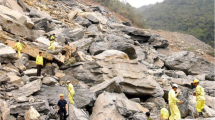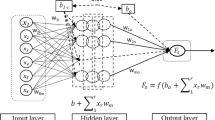Abstract
This study aims to develop a new artificial intelligence model for analyzing and evaluating slope stability in open-pit mines. Indeed, a novel hybrid intelligent technique based on an optimization of the cubist algorithm by an evolutionary method (i.e., PSO), namely PSO-CA technique, was developed for predicting the factor of safety (FS) in slope stability; 450 simulations from the Geostudio software for the FS of a quarry mine (Vietnam) were used as the datasets for this aim. Five factors include bench height, slope angle, angle of internal friction, cohesion, and unit weight were used as the input variables for estimating FS in this work. To clarify the performance of the proposed PSO-CA technique in slope stability analysis, SVM, CART, and kNN models were also developed and assessed. Three performance indices, such as mean absolute error (MAE), root-mean-squared error (RMSE), and determination coefficient (R2), were computed to evaluate the accuracy of the predictive models. The results clarified that the proposed PSO-CA technique was the most dominant accuracy with an MAE of 0.009, RMSE of 0.025, and R2 of 0.981, in estimating the stability of slope. The remaining models (i.e., SVM, CART, kNN) obtained poorer performance with MAE from 0.014 to 0.038, RMSE 0.030–0.056, and R2 0.917–0.974.










Similar content being viewed by others
References
Lu P, Rosenbaum M (2003) Artificial neural networks and grey systems for the prediction of slope stability. Nat Hazards 30(3):383–398
Sakellariou M, Ferentinou M (2005) A study of slope stability prediction using neural networks. Geotech Geol Eng 23(4):419
Bishop AW (1955) The use of the slip circle in the stability analysis of slopes. Geotechnique 5(1):7–17
Spencer E (1967) A method of analysis of the stability of embankments assuming parallel inter-slice forces. Geotechnique 17(1):11–26
Price V, Morgenstern N (1965) The analysis of the stability of general slip surfaces. Excerpt Geotech 15(01):1–18
Sarma S (1973) Stability analysis of embankments and slopes. Geotechnique 23(3):423–433
Sarma SK (1979) Stability analysis of embankments and slopes. J Geotech Geoenvironmental Eng 105(GT12):1511–1524. https://doi.org/10.1680/geot.1973.23.3.423
Baker R (2006) A relation between safety factors with respect to strength and height of slopes. Comput Geotech 33(4–5):275–277
El-Ramly H, Morgenstern N, Cruden D (2002) Probabilistic slope stability analysis for practice. Can Geotech J 39(3):665–683
Tobutt D (1982) Monte Carlo simulation methods for slope stability. Comput Geosci 8(2):199–208
Cao Z, Wang Y, Li D (2017) Practical reliability analysis of slope stability by advanced Monte Carlo simulations in a spreadsheet. Probabilistic approaches for geotechnical site characterization and slope stability analysis. Springer, New York, pp 147–167
Irigaray C, El Hamdouni R, Jiménez-Perálvarez J, Fernández P, Chacón J (2012) Spatial stability of slope cuts in rock massifs using GIS technology and probabilistic analysis. Bull Eng Geol Environ 71(3):569–578
Kanungo D, Arora M, Sarkar S, Gupta R (2006) A comparative study of conventional, ANN black box, fuzzy and combined neural and fuzzy weighting procedures for landslide susceptibility zonation in Darjeeling Himalayas. Eng Geol 85(3–4):347–366
Gordan B, Armaghani DJ, Hajihassani M, Monjezi M (2016) Prediction of seismic slope stability through combination of particle swarm optimization and neural network. Eng Comput 32(1):85–97
Suman S, Khan S, Das S, Chand S (2016) Slope stability analysis using artificial intelligence techniques. Nat Hazards 84(2):727–748
Bui XN, Nguyen H, Le HA, Bui HB, Do NH (2019) Prediction of blast-induced air over-pressure in open-pit mine: assessment of different artificial intelligence techniques. Nat Resour Res. https://doi.org/10.1007/s11053-019-09461-0
Nguyen H, Bui X-N (2018) Predicting blast-induced air overpressure: a robust artificial intelligence system based on artificial neural networks and random forest. Nat Resour Res. https://doi.org/10.1007/s11053-018-9424-1
Nguyen H, Bui X-N, Bui H-B, Mai N-L (2018) A comparative study of artificial neural networks in predicting blast-induced air-blast overpressure at Deo Nai open-pit coal mine, Vietnam. Neural Comput Appl. https://doi.org/10.1007/s00521-018-3717-5
Nguyen H, Bui X-N, Tran Q-H, Mai N-L (2019) A new soft computing model for estimating and controlling blast-produced ground vibration based on hierarchical K-means clustering and cubist algorithms. Appl Soft Comput 77:376–386. https://doi.org/10.1016/jasoc-2019-01-042
Moayedi H, Armaghani DJ (2018) Optimizing an ANN model with ICA for estimating bearing capacity of driven pile in cohesionless soil. Eng Comput 34(2):347–356
Moayedi H, Hayati S (2018) Modelling and optimization of ultimate bearing capacity of strip footing near a slope by soft computing methods. Appl Soft Comput 66:208–219
Massimi V, Asadi-Zeydabady M, Buscema M, Dominici D, Lodwick W, Simeoni L (2016) The contribution of artificial adaptive system to limit the influence of systematic errors in the definition of the kinematic behavior of an extremely-slow landslide. Eng Geol 203:30–44
Ferentinou M, Fakir M (2018) Integrating rock engineering systems device and artificial neural networks to predict stability conditions in an open pit. Eng Geol 246:293–309
Nassr A, Esmaeili-Falak M, Katebi H, Javadi A (2018) A new approach to modeling the behavior of frozen soils. Eng Geol 246:82–90
Yilmazkaya E, Dagdelenler G, Ozcelik Y, Sonmez H (2018) Prediction of mono-wire cutting machine performance parameters using artificial neural network and regression models. Eng Geol 239:96–108
Nie W, Zhao Z, Goh A, Song M, Guo W, Zhu X (2018) Performance based support design for horseshoe-shaped rock caverns using 2D numerical analysis. Eng Geol 245:266–279
Zhang X, Nguyen H, Bui X-N, Tran Q-H, Nguyen D-A, Bui DT, Moayedi H (2019) Novel soft computing model for predicting blast-induced ground vibration in open-pit mines based on particle swarm optimization and XGBoost. Nat Resour Res. https://doi.org/10.1007/s11053-019-09492-7
Nguyen H, Moayedi H, Jusoh WAW, Sharifi A (2019) Proposing a novel predictive technique using M5Rules-PSO model estimating cooling load in energy-efficient building system. Eng Comput. https://doi.org/10.1007/s00366-019-00735-y
Nguyen H, Moayedi H, Foong LK, Al Najjar HAH, Jusoh WAW, Rashid ASA, Jamali J (2019) Optimizing ANN models with PSO for predicting short building seismic response. Eng Comput. https://doi.org/10.1007/s00366-019-00733-0
Nguyen H, Drebenstedt C, Bui X-N, Bui DT (2019) Prediction of blast-induced ground vibration in an open-pit mine by a novel hybrid model based on clustering and artificial neural network. Nat Resour Res. https://doi.org/10.1007/s11053-019-09470-z
Moayedi H, Hayati S (2018) Artificial intelligence design charts for predicting friction capacity of driven pile in clay. Neural Comput Appl. https://doi.org/10.1007/s00521-018-3555-5
Moayedi Hayati S (2018) Applicability of a CPT-based neural network solution in predicting load-settlement responses of bored pile. Int J Geomech 18(6):06018009
Dou J, Chang K-T, Chen S, Yunus A, Liu J-K, Xia H, Zhu Z (2015) Automatic case-based reasoning approach for landslide detection: integration of object-oriented image analysis and a genetic algorithm. Remote Sens 7(4):4318–4342
Dou J, Yamagishi H, Pourghasemi HR, Yunus AP, Song X, Xu Y, Zhu Z (2015) An integrated artificial neural network model for the landslide susceptibility assessment of Osado Island, Japan. Nat Hazards 78(3):1749–1776
Dou J, Yunus AP, Bui DT, Merghadi A, Sahana M, Zhu Z, Chen C-W, Khosravi K, Yang Y, Pham BT (2019) Assessment of advanced random forest and decision tree algorithms for modeling rainfall-induced landslide susceptibility in the Izu-Oshima Volcanic Island, Japan. Sci Total Environ 662:332–346
Dou J, Yunus AP, Tien Bui D, Sahana M, Chen C-W, Zhu Z, Wang W, Pham BT (2019) Evaluating GIS-based multiple statistical models and data mining for earthquake and rainfall-induced landslide susceptibility using the LiDAR DEM. Remote Sens 11(6):638
Hoang N-D, Pham A-D (2016) Hybrid artificial intelligence approach based on metaheuristic and machine learning for slope stability assessment: a multinational data analysis. Expert Syst Appl 46:60–68
Gandomi A, Kashani A, Mousavi M, Jalalvandi M (2017) Slope stability analysis using evolutionary optimization techniques. Int J Numer Anal Methods Geomech 41(2):251–264
Koopialipoor M, Armaghani DJ, Hedayat A, Marto A, Gordan B (2018) Applying various hybrid intelligent systems to evaluate and predict slope stability under static and dynamic conditions. Soft Comput 23:1–17
Moayedi H, Nguyen H, Rashid ASA (2019) Novel metaheuristic classification approach in developing mathematical model-based solutions predicting failure in shallow footing. Eng Comput. https://doi.org/10.1007/s00366-019-00819-9
Saha A (2018) Artificial bee colony (abc) algorithm applied to slope-stability in searching the critical surface. Disponível, Kolkata:[sn] em:https://www.researchgatenet/publication/294087456 Acesso em 15
Qi C, Tang X (2018) Slope stability prediction using integrated metaheuristic and machine learning approaches: a comparative study. Comput Ind Eng 118:112–122
Das SK, Biswal RK, Sivakugan N, Das B (2011) Classification of slopes and prediction of factor of safety using differential evolution neural networks. Environ Earth Sci 64(1):201–210
Gao W, Raftari M, Rashid ASA, Mu’azu MA, Jusoh WAW (2019) A predictive model based on an optimized ANN combined with ICA for predicting the stability of slopes. Eng Comput. https://doi.org/10.1007/s00366-019-00702-7
Samui P, Kothari D (2011) Utilization of a least square support vector machine (LSSVM) for slope stability analysis. Sci Iran 18(1):53–58
Erzin Y, Cetin T (2013) The prediction of the critical factor of safety of homogeneous finite slopes using neural networks and multiple regressions. Comput Geosci 51:305–313
Feng X, Li S, Yuan C, Zeng P, Sun Y (2018) Prediction of slope stability using naive Bayes classifier. KSCE J Civ Eng 22(3):941–950
Liu L, Moayedi H, Rashid ASA, Rahman SSA, Nguyen H (2019) Optimizing an ANN model with genetic algorithm (GA) predicting load-settlement behaviours of eco-friendly raft-pile foundation (ERP) system. Eng Comput. https://doi.org/10.1007/s00366-019-00767-4
Gao W, Wu H, Siddiqui MK, Baig AQ (2018) Study of biological networks using graph theory. Saudi J Biol Sci 25(6):1212–1219
Nguyen H, Bui X-N, Bui H-B, Cuong D (2019) Developing A XGBoost model to predict blast-induced peak particle velocity in open cast mine: a case study. Acta Geophys 67:477–490
Adankon MM, Cheriet M (2009) Support vector machine. Encyclopedia of biometrics. Springer, New York, pp 1303–1308
Breiman L (2017) Classification and regression trees. Routledge, Abingdon
Yang K, Cai Y, Cai Z, Xie H, Wong T-L, Chan WH (2019) Top K representative: a method to select representative samples based on K nearest neighbors. Int J Mach Learn Cybern 10(8):2119–2129. https://doi.org/10.1007/s13042-017-0755-8
Rulequest (2016) Data mining with cubist. https://www.rulequest.com/cubist-win.html
Quinlan JR Learning with continuous classes. In: 5th Australian joint conference on artificial intelligence, 1992. Singapore, pp 343–348
Gao W, Wang W, Dimitrov D, Wang Y (2018) Nano properties analysis via fourth multiplicative ABC indicator calculating. Arab J Chem 11(6):793–801
Rulequest (2016) Data mining with cubist. https://www.rulequestcom/cubist-infohtml RuleQuest Research Pty Ltd.,St. Ives, NSW, Australia. Accessed 15 June 2019
Kennedy J (2010) Particle swarm optimization. Encyclopedia of machine learning. Springer, New York, pp 760–766
Clerc M, Kennedy J (2002) The particle swarm-explosion, stability, and convergence in a multidimensional complex space. IEEE Trans Evol Comput 6(1):58–73
Gao W, Guirao JLG, Abdel-Aty M, Xi W (2018) An independent set degree condition for fractional critical deleted graphs. Discret Contin Dyn Syst-Ser 12(4&5):877–886. https://doi.org/10.3934/dcdss.2019058
Gao W, Guirao JL, Basavanagoud B, Wu J (2018) Partial multi-dividing ontology learning algorithm. Inf Sci 467:35–58
Poli R, Kennedy J, Blackwell T (2007) Particle swarm optimization. Swarm Intell 1(1):33–57
Zhou Y, Cheuk C, Tham L (2009) Numerical modelling of soil nails in loose fill slope under surcharge loading. Comput Geotech 36(5):837–850
Kohavi R (1995) A study of cross-validation and bootstrap for accuracy estimation and model selection. Ijcai, vol 2. Montreal, Canada, pp 1137–1145
Acknowledgements
The authors would like to thank the Hanoi University of Mining and Geology (HUMG), Hanoi, Vietnam, Duy Tan University, Da Nang, Vietnam, and the Center for Mining, Electro-Mechanical research of HUMG.
Author information
Authors and Affiliations
Corresponding authors
Ethics declarations
Conflict of interest
The authors declare that they have no conflicts of interest.
Additional information
Publisher's Note
Springer Nature remains neutral with regard to jurisdictional claims in published maps and institutional affiliations.
Rights and permissions
About this article
Cite this article
Luo, Z., Bui, XN., Nguyen, H. et al. A novel artificial intelligence technique for analyzing slope stability using PSO-CA model. Engineering with Computers 37, 533–544 (2021). https://doi.org/10.1007/s00366-019-00839-5
Received:
Accepted:
Published:
Issue Date:
DOI: https://doi.org/10.1007/s00366-019-00839-5





